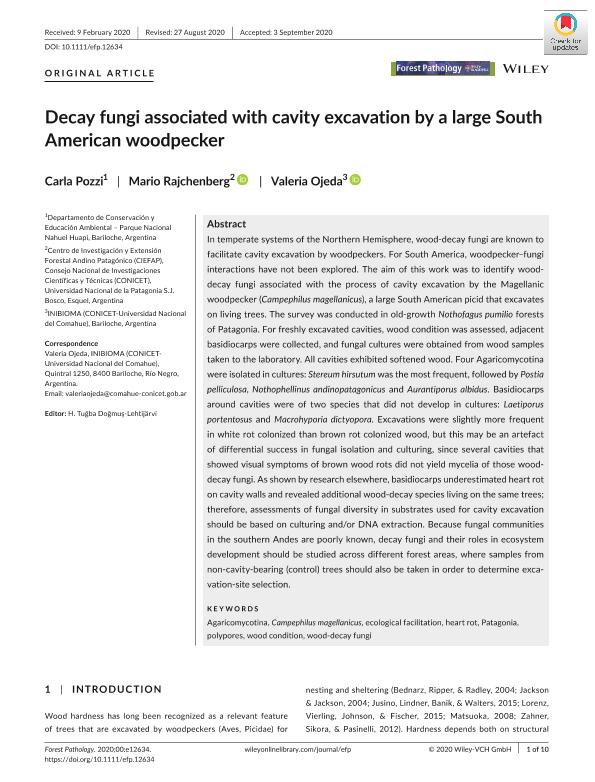Mostrar el registro sencillo del ítem
dc.contributor.author
Pozzi, Carla Martina

dc.contributor.author
Rajchenberg, Mario

dc.contributor.author
Ojeda, Valeria Susana

dc.date.available
2022-03-22T02:45:32Z
dc.date.issued
2020-10
dc.identifier.citation
Pozzi, Carla Martina; Rajchenberg, Mario; Ojeda, Valeria Susana; Decay fungi associated with cavity excavation by a large South American woodpecker; Wiley Blackwell Publishing, Inc; Forest Pathology; 50; 5; 10-2020; 1-10
dc.identifier.issn
1437-4781
dc.identifier.uri
http://hdl.handle.net/11336/153670
dc.description.abstract
In temperate systems of the Northern Hemisphere, wood-decay fungi are known to facilitate cavity excavation by woodpeckers. For South America, woodpecker–fungi interactions have not been explored. The aim of this work was to identify wooddecay fungi associated with the process of cavity excavation by the Magellanic woodpecker (Campephilus magellanicus), a large South American picid that excavates on living trees. The survey was conducted in old-growth Nothofagus pumilio forests of Patagonia. For freshly excavated cavities, wood condition was assessed, adjacent basidiocarps were collected, and fungal cultures were obtained from wood samples taken to the laboratory. All cavities exhibited softened wood. Four Agaricomycotina were isolated in cultures: Stereum hirsutum was the most frequent, followed by Postia pelliculosa, Nothophellinus andinopatagonicus and Aurantiporus albidus. Basidiocarps around cavities were of two species that did not develop in cultures: Laetiporus portentosus and Macrohyporia dictyopora. Excavations were slightly more frequent in white rot colonized than brown rot colonized wood, but this may be an artefact of differential success in fungal isolation and culturing, since several cavities that showed visual symptoms of brown wood rots did not yield mycelia of those wooddecay fungi. As shown by research elsewhere, basidiocarps underestimated heart rot on cavity walls and revealed additional wood-decay species living on the same trees; therefore, assessments of fungal diversity in substrates used for cavity excavation should be based on culturing and/or DNA extraction. Because fungal communities in the southern Andes are poorly known, decay fungi and their roles in ecosystem development should be studied across different forest areas, where samples from non-cavity-bearing (control) trees should also be taken in order to determine excavation-site selection.
dc.format
application/pdf
dc.language.iso
eng
dc.publisher
Wiley Blackwell Publishing, Inc

dc.rights
info:eu-repo/semantics/openAccess
dc.rights.uri
https://creativecommons.org/licenses/by-nc-sa/2.5/ar/
dc.subject
AGARICOMYCOTINA
dc.subject
CAMPEPHILUS MAGELLANICUS
dc.subject
ECOLOGICAL FACILITATION
dc.subject
HEART ROT
dc.subject
PATAGONIA
dc.subject
POLYPORES
dc.subject
WOOD CONDITION
dc.subject
WOOD-DECAY FUNGI
dc.subject.classification
Micología

dc.subject.classification
Ciencias Biológicas

dc.subject.classification
CIENCIAS NATURALES Y EXACTAS

dc.title
Decay fungi associated with cavity excavation by a large South American woodpecker
dc.type
info:eu-repo/semantics/article
dc.type
info:ar-repo/semantics/artículo
dc.type
info:eu-repo/semantics/publishedVersion
dc.date.updated
2022-03-14T21:08:56Z
dc.identifier.eissn
1478-6427
dc.journal.volume
50
dc.journal.number
5
dc.journal.pagination
1-10
dc.journal.pais
Reino Unido

dc.journal.ciudad
Londres
dc.description.fil
Fil: Pozzi, Carla Martina. Ministerio de Ambiente y Desarrollo Sustentable. Administración de Parques Nacionales. Parque Nacional "Nahuel Huapi". Departamento Conservación y Educación Ambiental; Argentina
dc.description.fil
Fil: Rajchenberg, Mario. Centro de Investigación y Extensión Forestal Andino Patagónico; Argentina. Universidad Nacional de la Patagonia "San Juan Bosco"; Argentina. Consejo Nacional de Investigaciones Científicas y Técnicas. Centro Científico Tecnológico Conicet - Centro Nacional Patagónico; Argentina
dc.description.fil
Fil: Ojeda, Valeria Susana. Consejo Nacional de Investigaciones Cientificas y Tecnicas. Centro Cientifico Tecnologico Conicet - Patagonia Norte. Instituto de Investigaciones En Biodiversidad y Medioambiente. Subsede Junín de Los Andes-inibioma-centro de Ecología Aplicada del Neuquén (cean) | Universidad Nacional del Comahue. Centro Regional Universitario Bariloche. Instituto de Investigaciones En Biodiversidad y Medioambiente. Subsede Junín de Los Andes-inibioma-centro de Ecología Aplicada del Neuquén (cean).; Argentina
dc.journal.title
Forest Pathology

dc.relation.alternativeid
info:eu-repo/semantics/altIdentifier/url/https://onlinelibrary.wiley.com/doi/full/10.1111/efp.12634
dc.relation.alternativeid
info:eu-repo/semantics/altIdentifier/doi/http://dx.doi.org/10.1111/efp.12634
Archivos asociados
